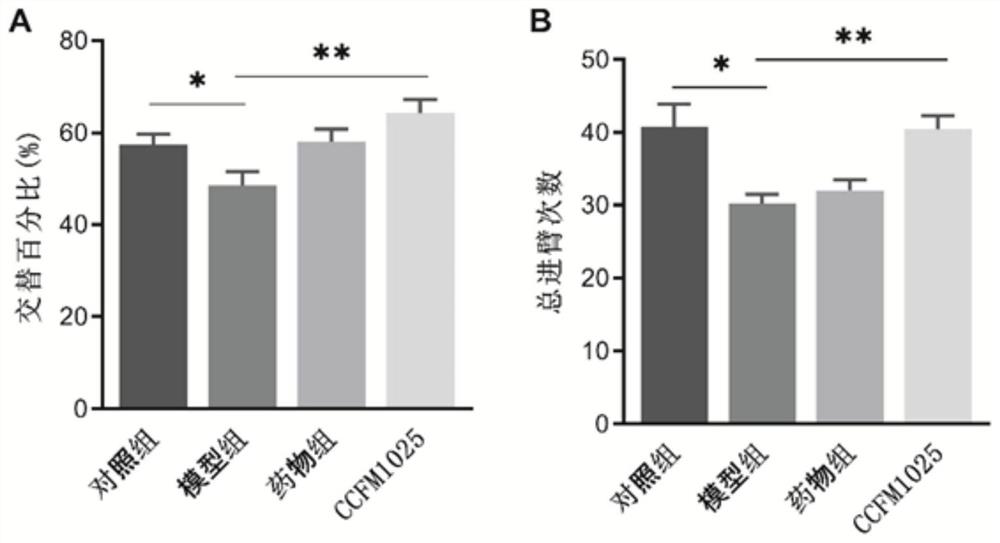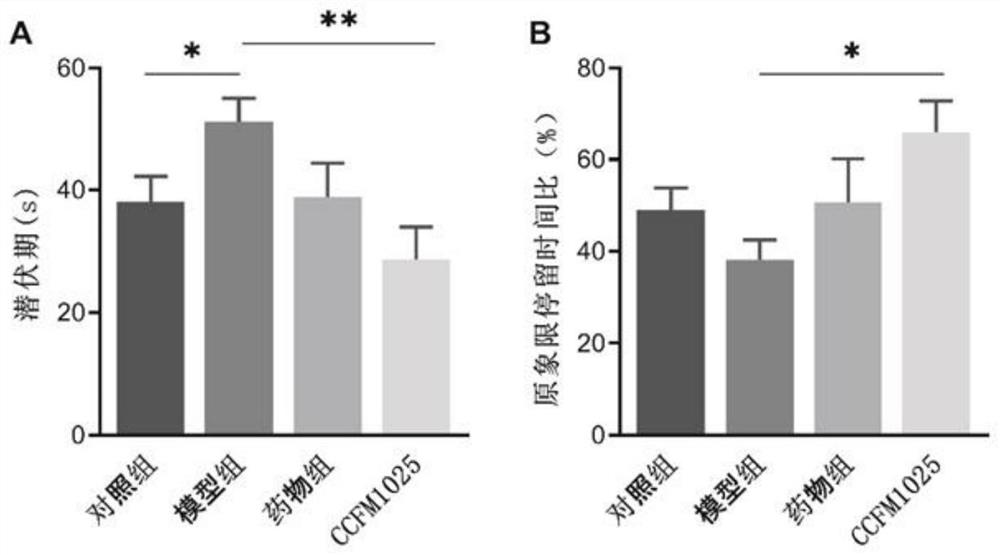Application of bifidobacterium breve CCFM1025 in relieving Alzheimer's disease
A technology of CCFM1025 and Bifidobacterium breve, which is applied in the field of microbiology, can solve the problems of complex research methods of intestinal flora, few clinical studies of intestinal flora, and lack of types of spiritual probiotics, etc., so as to increase the relative abundance and improve Cognitive impairment, content-enhancing effect
- Summary
- Abstract
- Description
- Claims
- Application Information
AI Technical Summary
Problems solved by technology
Method used
Image
Examples
Embodiment 1
[0042] Example 1: Bifidobacterium breve CCFM1025 improves the behavioral indicators of Alzheimer's disease mice
[0043] Thirty-two 7-week-old male C57BL / 6J mice were taken, and after one week of adaptation to the environment, Aβ1-42 protein was microinjected into the brain hippocampus at one time to establish an animal model of Alzheimer's disease. On the third day after the model was established, the animals were divided into Four groups: control group (injection of equal volume of normal saline), model group, drug intervention group, and CCFM1025 intervention group, with 8 mice in each group. The animal groups and treatment methods are shown in Table 1.
[0044] Table 1 Grouping and processing methods of animal experiments
[0045]
[0046]
[0047] AD mouse model induced by microinjection of Aβ1-42 protein in the brain: After the mice were adapted for one week, the mice in each group were anesthetized with isoflurane (induction concentration 3%, maintenance concentr...
Embodiment 2
[0060] Example 2: CCFM1025 reduces Aβ protein deposition in the brains of Alzheimer's mice
[0061] The mouse grouping, modeling and treatment methods were the same as in Example 1. After the mouse behavior experiment, the next day, the mice were injected intraperitoneally with 1% pentobarbital sodium solution to make them anesthetized, and the mice were killed. The brain tissue of the mice was taken and separated on ice. Hippocampus. Take a certain quality of fresh hippocampus tissue, add 9 times the volume of sterile PBS buffer solution (equivalent to 1g tissue plus 9ml homogenate), homogenize with a tissue homogenizer, and take the supernatant after the tissue fluid is centrifuged at 3000g for 15min. The content of β-amyloid protein (Aβ1-42) in hippocampus was detected by ELISA kit.
[0062] Experimental results such as Figure 4 As shown, the results show that the intervention of Bifidobacterium breve CCFM1025 can significantly reduce the deposition of Aβ1-42 protein in...
Embodiment 3
[0063] Example 3: Bifidobacterium breve CCFM1025 increases the levels of neurotransmitters and synaptic proteins in the brains of Alzheimer's mice
[0064] Take a certain amount of brain tissue obtained in Example 2, add 9 times the volume of sterile PBS buffer (equivalent to 1g of tissue plus 9ml of homogenate), homogenize with a tissue homogenizer, and take the tissue fluid after centrifugation at 3000g and 15min. In the supernatant, ELISA kit was used to detect the content of brain-derived neurotrophic factor BDNF in the brain tissue.
[0065] Experimental results such as Figure 5 As shown in A, the results showed that the intervention of Bifidobacterium breve CCFM1025 significantly reversed the reduction of BDNF levels in the brains of Alzheimer's disease model mice, and restored the BDNF content from 143.66pg / mL in the model group to 172.55pg / mL, compared with The content of the control group was the same, and the improvement effect of CCFM1025 on BDNF in the brain was ...
PUM
 Login to View More
Login to View More Abstract
Description
Claims
Application Information
 Login to View More
Login to View More - R&D Engineer
- R&D Manager
- IP Professional
- Industry Leading Data Capabilities
- Powerful AI technology
- Patent DNA Extraction
Browse by: Latest US Patents, China's latest patents, Technical Efficacy Thesaurus, Application Domain, Technology Topic, Popular Technical Reports.
© 2024 PatSnap. All rights reserved.Legal|Privacy policy|Modern Slavery Act Transparency Statement|Sitemap|About US| Contact US: help@patsnap.com










